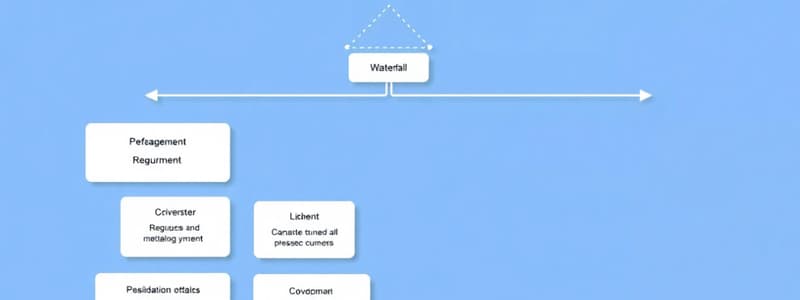Podcast
Questions and Answers
What is the main focus of the V Shaped model compared to the Waterfall model?
What is the main focus of the V Shaped model compared to the Waterfall model?
- Incorporating iterative development
- Focusing on maintenance tasks
- Emphasizing on testing processes (correct)
- Emphasizing on design documentation
What is the first phase of the Spiral model in the development process?
What is the first phase of the Spiral model in the development process?
- Development and verification
- Risk assessment and resolution
- Testing and validation
- Identifying objectives, constraints, and alternatives (correct)
Which of the following best describes a characteristic of the Spiral model?
Which of the following best describes a characteristic of the Spiral model?
- Emphasizes risk identification and resolution (correct)
- Focuses primarily on the maintenance phase
- Phases are completed strictly sequentially
- Releases are all at once after full development
How does the Waterfall model treat the transitions between phases?
How does the Waterfall model treat the transitions between phases?
What does the SRS stand for in the context of the Waterfall model?
What does the SRS stand for in the context of the Waterfall model?
What is the primary purpose of requirements elicitation?
What is the primary purpose of requirements elicitation?
Which activity involves ensuring the requirements are consistent and meet stakeholder needs?
Which activity involves ensuring the requirements are consistent and meet stakeholder needs?
What is a common trait of good requirements?
What is a common trait of good requirements?
What is involved in requirements verification?
What is involved in requirements verification?
During which phase are requirements often documented in a requirements specification document?
During which phase are requirements often documented in a requirements specification document?
What is the primary purpose of the Concept of Operations (ConOps) document?
What is the primary purpose of the Concept of Operations (ConOps) document?
Which of the following is NOT part of the information contained in a ConOps document?
Which of the following is NOT part of the information contained in a ConOps document?
What type of test methods can be proposed in a trace table?
What type of test methods can be proposed in a trace table?
Which of the following describes a Factory Acceptance Test (FAT)?
Which of the following describes a Factory Acceptance Test (FAT)?
In the context of requirements, what does the term flow-down refer to?
In the context of requirements, what does the term flow-down refer to?
What does the acronym CSCI represent in the context of test events?
What does the acronym CSCI represent in the context of test events?
Which of the following is NOT a test level indicated in the trace table?
Which of the following is NOT a test level indicated in the trace table?
What aspect does the ConOps document help establish for customers/users?
What aspect does the ConOps document help establish for customers/users?
The terms 'SW Functional Qualification Test' and 'Site Acceptance Test' refer to which aspect of system requirements?
The terms 'SW Functional Qualification Test' and 'Site Acceptance Test' refer to which aspect of system requirements?
Which of the following best describes the insight provided by a ConOps document to the engineering team?
Which of the following best describes the insight provided by a ConOps document to the engineering team?
What is a key trait of a good requirement regarding its wording?
What is a key trait of a good requirement regarding its wording?
Which requirement example demonstrates ambiguity?
Which requirement example demonstrates ambiguity?
What aspect of good requirements ensures that they do not lead to confusion?
What aspect of good requirements ensures that they do not lead to confusion?
Which of the following is NOT a characteristic of a clear requirement?
Which of the following is NOT a characteristic of a clear requirement?
What is an essential attribute of complete requirements?
What is an essential attribute of complete requirements?
Which statement reflects the need for consistency among requirements?
Which statement reflects the need for consistency among requirements?
Why should requirements avoid containing definitions or reasons for their need?
Why should requirements avoid containing definitions or reasons for their need?
What is the consequence of having ambiguous requirements?
What is the consequence of having ambiguous requirements?
What does the CSCI acronym stand for?
What does the CSCI acronym stand for?
Which layer of the CSU System Architecture contains Configuration Items?
Which layer of the CSU System Architecture contains Configuration Items?
Which item is a Software Design Item in the CSU System Architecture?
Which item is a Software Design Item in the CSU System Architecture?
What is the purpose of a traceability matrix in system requirements?
What is the purpose of a traceability matrix in system requirements?
Which of the following represents upward traceability in requirements?
Which of the following represents upward traceability in requirements?
Which requirement best exemplifies a downward traceability feature?
Which requirement best exemplifies a downward traceability feature?
What is the role of the Support Item (SI) in the CSU System?
What is the role of the Support Item (SI) in the CSU System?
What component is likely to fall under the 'Operations Support' category?
What component is likely to fall under the 'Operations Support' category?
Which characteristic is NOT typically associated with traits of good requirements?
Which characteristic is NOT typically associated with traits of good requirements?
What does 'A-level spec' primarily focus on within the CSU System?
What does 'A-level spec' primarily focus on within the CSU System?
Which item is NOT categorized as a Software Component?
Which item is NOT categorized as a Software Component?
How is the design of the CSU System primarily structured?
How is the design of the CSU System primarily structured?
Which of the following systems aids in monitoring student progress?
Which of the following systems aids in monitoring student progress?
Flashcards are hidden until you start studying
Study Notes
Software Development Models
-
Classic Waterfall Model: Sequential phases including Requirements, Design, Code & Unit Test, Integration, Test, Deployment, and Maintenance; produces documents at each stage such as the Software Requirements Specification (SRS) and Software Architecture Document (SAD).
-
V-Shaped Model: Introduced by Paul Rook in the 1980s; emphasizes testing throughout each phase; requires completion of a phase before moving to the next; visual representation shows upward bending process steps.
-
Spiral Model: Developed by Barry Boehm in 1986; consists of four stages evaluated in a cyclic manner: Objectives identification, Risk evaluation and resolution, Product development, and Verification of the next product level.
Requirement Engineering Activities
- Requirements Inception: Gathering requirements through user and stakeholder engagement.
- Requirements Identification: Recognizing and documenting new requirements.
- Requirements Analysis and Negotiation: Reviewing requirements and resolving stakeholder differences.
- Requirements Definition: Detailing both functional and non-functional requirements.
- Requirements Specification: Creating a formal requirements document.
- Requirements Validation: Ensuring that documented requirements align with stakeholder needs.
- Requirements Verification: Confirming that the final product meets the specified requirements.
- Requirements Management: Overseeing changes in requirements during development and after deployment.
Traits of Good Requirements
-
Clarity and Simplicity: Requirements should be clear, concise, and comprehensible to non-technical stakeholders; ideally should be single-phrased with no more than 30-50 words.
-
Completeness: All necessary information must be included, leaving no ambiguity regarding system functions or measurement units.
-
Consistency: Requirements must not contradict one another; they should agree on specific details like compliance standards (e.g., TCP/IPv6).
-
Avoidance of Ambiguity: Requirements should not involve vague terms; each requirement must be precise and measurable to avoid multiple interpretations.
Examples of Good vs. Bad Requirements
- Good Requirement: "The system shall cease automatic steering upon receipt of a State Change Message indicating 'Off.'"
- Bad Requirement: "All screens shall appear on the monitor quickly." (This is vague and non-specific about timing.)
CSU System Architecture Layers
- The CSU System comprises multiple layers: Computer, Communication, Mobile, and Facilities.
- Under each layer, different types of design items are categorized, including Hardware Design Items and Software Design Items.
- Configuration items are represented as DP, VPS, VTC, AVS, HWCIs (Hardware Configuration Items), CSCIs (Software Configuration Items), and SIs (Support Items).
- Subsystems include components like CSU1, CSU2, LMS (Logistics Management System), TRN (Training Management System), and EDE.
Traits of Good Requirements
- Requirements must be traceable upward to the original specifications and downward to design, implementation, and testing.
- Traceability matrices are essential in tracking relationships between child and parent requirements.
- Each requirement should also detail its integrations and corresponding testing procedures, ensuring all components meet specified standards.
Concept of Operations (ConOps) Document
- The ConOps document outlines how customers or users plan to utilize the product without detailing how it operates or setting requirements.
- It guides the engineering team by providing insights into user needs and expectations, establishing a clear rationale for the requirements.
- ConOps ensures consistency in customer expectations over time.
Trace Tables
- Trace tables document each requirement alongside its parent requirement(s), outlining test procedures and proposed test methods.
- Test methods include demonstration (D), analysis (A), testing (T), and inspection (I).
- Test levels indicate the type of evaluation, such as Factory Acceptance Test (FAT), Software Functional Qualification Test (CSCI), and System Test.
System Requirements Flowdown
- A-level system requirements flow down to B-level subsystems and configuration items, helping maintain a clear hierarchical structure of requirements.
- This flowdown ensures that every subsystem and configuration item aligns with overarching system goals and specifications.
Studying That Suits You
Use AI to generate personalized quizzes and flashcards to suit your learning preferences.




